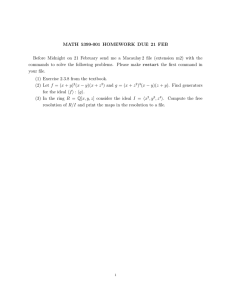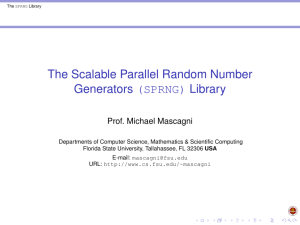: A Scalable Library for Pseudorandom Number Generation Michael Mascagni ( )
advertisement
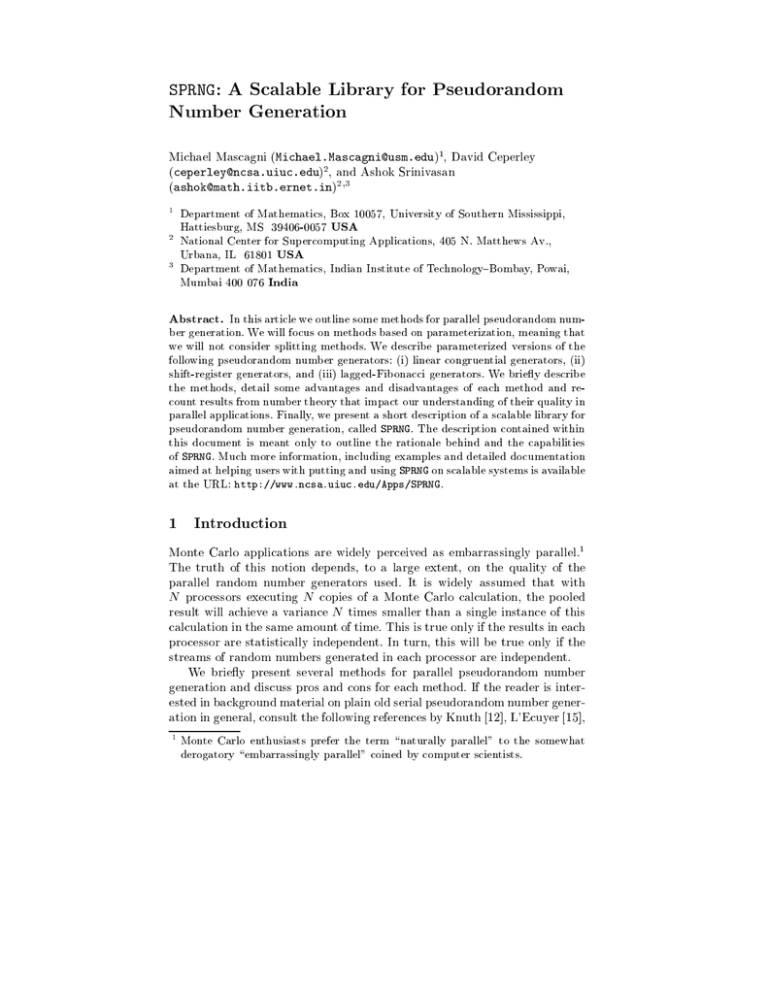
SPRNG:
A Scalable Library for Pseudorandom
Number Generation
Michael Mascagni (Michael.Mascagni@usm.edu)1, David Ceperley
(ceperley@ncsa.uiuc.edu)2, and Ashok Srinivasan
(ashok@math.iitb.ernet.in)2;3
1
2
3
Department of Mathematics, Box 10057, University of Southern Mississippi,
Hattiesburg, MS 39406-0057 USA
National Center for Supercomputing Applications, 405 N. Matthews Av.,
Urbana, IL 61801 USA
Department of Mathematics, Indian Institute of Technology{Bombay, Powai,
Mumbai 400 076 India
Abstract. In this article we outline some methods for parallel pseudorandom number generation. We will focus on methods based on parameterization, meaning that
we will not consider splitting methods. We describe parameterized versions of the
following pseudorandom number generators: (i) linear congruential generators, (ii)
shift-register generators, and (iii) lagged-Fibonacci generators. We briey describe
the methods, detail some advantages and disadvantages of each method and recount results from number theory that impact our understanding of their quality in
parallel applications. Finally, we present a short description of a scalable library for
pseudorandom number generation, called SPRNG. The description contained within
this document is meant only to outline the rationale behind and the capabilities
of SPRNG. Much more information, including examples and detailed documentation
aimed at helping users with putting and using SPRNG on scalable systems is available
at the URL: http://www.ncsa.uiuc.edu/Apps/SPRNG.
1 Introduction
Monte Carlo applications are widely perceived as embarrassingly parallel.1
The truth of this notion depends, to a large extent, on the quality of the
parallel random number generators used. It is widely assumed that with
N processors executing N copies of a Monte Carlo calculation, the pooled
result will achieve a variance N times smaller than a single instance of this
calculation in the same amount of time. This is true only if the results in each
processor are statistically independent. In turn, this will be true only if the
streams of random numbers generated in each processor are independent.
We briey present several methods for parallel pseudorandom number
generation and discuss pros and cons for each method. If the reader is interested in background material on plain old serial pseudorandom number generation in general, consult the following references by Knuth [12], L'Ecuyer [15],
1
Monte Carlo enthusiasts prefer the term \naturally parallel" to the somewhat
derogatory \embarrassingly parallel" coined by computer scientists.
II
Michael Mascagni et al.
Niederreiter [33], and Park and Miller [34], while a good overview of parallel pseudorandom number generation can be found in a recent work by the
present article's author(s) [28,38].
In our parallel pseudorandom number generation review we are interested, exclusively, with methods for obtaining parallel pseudorandom number
generators (PPRNGs) via parameterization. The exact meaning of parameterization depends on the type of PRNG under discussion, but we wish to
distinguish parameterization from splitting methods. We will not be considering the production of parallel streams of pseudorandom numbers by taking
substreams from a single, long-period PRNG. For readers interested in splitting methods and the consequences of using split streams in parallel please
consult the works by Deak [5], De Matteis and Pagnutti [7{9], Frederickson
et al. [10], and L'Ecuyer and C^ote [16]. In general, we seek to determine a
parameter in the underlying recursion of the PRNG that can be varied. Each
valid value of this parameter will lead to a recursion that produces a unique,
full-period stream of pseudorandom numbers. We then discuss ecient means
to specify valid parameter values and consider these choices in terms of the
quality of the pseudorandom numbers produced.
The plan of the paper is as follows. In x2 we present an extensive overview
of parallel pseudorandom number generation mostly viewed from the parameterization point of view. In x2.1 two methods for parameterizing linear
congruential generators (LCGs). In x2.2 we present a parameterization of another linear method: shift-register generators (SRGs). This parameterization
is analogous to one of the LCG parameterizations presented in x2.1. In x2.3
we consider the parallel parameterization of so-called lagged-Fibonacci generators. In x3, we present the Scalable Parallel Random Number Generators
(SPRNG) library, a comprehensive tool for parallel and distributed pseudorandom number generation developed by the authors. Finally in x4 we discuss
open problems, and provide concluding remarks.
2 Parallel Pseudorandom Number Generation
In this next, rather extensive, section we will look at several methods for parallel pseudorandom number generation. Most of the methods we will present
will be based on some kind of parameterization of the generators.
2.1 Linear Congruential Generators
The most commonly used generator for pseudorandom numbers is the LCG.
The LCG was rst proposed for use by Lehmer [17], and is referred to as
the Lehmer generator in the early literature. The linear recursion underlying
LCGs is:
xn = axn;1 + b (mod m):
SPRNG
III
When the multiplier, a, additive constant, b, and modulus, m, are chosen
appropriately one obtains a purely periodic sequence with period as long as
Per(xn ) = 2k , when m is a power-of-two, and Per(xn ) = m ; 1, when m is
prime. It is well known that s-tuples made up from LCGs lie on lattices composed of a family of parallel hyperplanes, Marsaglia [22]. The xn 's in Eq. (2.1)
are integer residues modulo m, and a uniform pseudorandom number in [0,1]
is produced via zn = xn =m, and the initial value of the LCG, x0 , is often
called the seed.
The most important parameter of an LCG is the modulus, m. Its size
constrains the period, and for implementational reasons it is always chosen to
be either prime or a power-of-two. Based on which type of modulus is chosen,
there is a dierent parameterization method. When m is prime, a method
based on using the multiplier, a, as the parameter has been proposed. The
rationale for this choice is outlined in Mascagni [27], and leads to several
interesting computational problems.
2.1.1 Prime Modulus
Given we wish to parameterize a when m is prime we must determine
rst the family of permissible a's. A condition on a when m is prime to
obtain the maximal period (of length m ; 1 in this case) is that a must
be a primitive element modulo m, Knuth [12].2 Given primitivity, one can
use the following fact: if a and are primitive elements modulo m then
= ai (mod m) for some i relatively prime to (m). Note that when m is
prime that (m) = m ; 1. Thus a single, reference, primitive element, a,
and an explicit enumeration of the integers relatively prime to m ; 1 furnish
an explicit parameterization for the j th primitive element, aj as aj = a`j
(mod m) where `j is the j th integer relatively prime to m ; 1. Given an
explicit factorization of m ; 1, Brillhart et al. [3], ecient algorithms for
computing `j can be found in a recent work of the author [27]. An interesting
open question in this regard is whether the overall eciency of this PPRNG is
minimized by choosing the prime modulus to minimize the cost of computing
`j or to minimize the cost of modular multiplication modulo m.
Given this scheme there are some positive and negative features to be
mentioned. A motivation for this scheme is that a common theoretical measure of the correlation among parallel streams predicts little correlation. This
measure is based on exponential sums. Exponential sums are of interest in
many areas of number theory. We dene the exponential sum for the sequence
of residues modulo m, fxn gkn;=01 , as:
C (k) =
2
kX
;1 2i
e m xn :
n=0
An integer, a, is primitive modulo m if the set of integers fai (mod m)j1 i m ; 1g equals the set f1 i m ; 1g.
IV
Michael Mascagni et al.
If the xn are periodic and k is the period, then Eq. (2.1) is called a fullperiod exponential sum. If xn is periodic and k is less than the full period,
then Eq. (2.1) is a partial-period exponential sum. Examining Eq. (2.1) shows
it to be a sum of k quantities on the unit circle. A trivial upper bound is
thus jC (k)j k. If the sequence
p fxn g is indeed uniformly distributed, then we
would expect jC (k)j = O( k), Kuipers and Niederreiter [13]. Thus the desire
is to show that exponential sums of interest are neither too big nor too small
to reassure us that the sequence in question is theoretically equidistributed.
Since we are interested in studying sequences for use in parallel, we must
consider the cross-correlations among the sequences to be used on dierent
processors. If fxn g and fyn g are two sequences of interest then their exponential sum cross-correlation is given by:
C (i; j; k) =
kX
;1 2i
e m (xi+n ;yj+n) :
n=0
Here the sum has k terms and begins with xi and yj .
In a previous work we only considered full-period exponential sum crosscorrelation for studying these issues for a dierent recursion, Pryor et al. [36].
We will take the same approach here. Suppose we have j full-period LCGs
dened by xkn = a`i xkn;1 (mod m), 0 k < j . All of the pairwise full-period
exponential sum cross-correlations are known to satisfy, Schmidt [37]:
p
jC (m)j max
`
; 1 m:
k k
The choice of the exponents, `k , that minimizes Eq. (2.1) is to make `j the j th
integer relatively prime to m ; 1. This necessitates an algorithm to compute
this j th integer relatively prime to an integer with known factorization, m ; 1.
This is discussed at great length in Mascagni [27]; however, two important
open questions remain: (1) is it more ecient overall to choose m to be
amenable to fast modular multiplication or fast calculation of the j th integer
relatively prime to m ; 1, and (2) does the good interstream correlation of
Eq. (2.1) also ensure good intrastream independence via the spectral test?
The rst of these questions is of practical interest to performance, the second;
however, if answered negatively, makes such techniques less attractive for
parallel pseudorandom number generation.
2.1.2 Power-of-two Modulus
An alternative way to use LCGs to make a PPRNG is to parameterize
the additive constant in Eq. (2.1) when the modulus is a power-of-two, i.e., to
m = 2k for some integer k > 1. This is a technique rst proposed by Percus
and Kalos [35], to provide a PPRNG for the NYU Ultracomputer. It has some
interesting advantages over parameterizing the multiplier; however, there are
some considerable disadvantages in using power-of-two modulus LCGs.
SPRNG
V
The parameterization chooses a set of additive constants fbj g that are
pairwise relatively prime, i.e. gcd(bi ; bj ) = 1 when i 6= j . A prudent choice is
to let bj be the j th prime. This both ensures the pairwise relative primality
and is the largest set of such residues. With this choice certain favorable interstream properties can be theoretically derived from the spectral test [35].
However, this choice necessitates a method for the dicult problem of computing the j th prime. In their paper, Percus and Kalos do not discuss this
aspect of their generator in detail, partly due to the fact that they expect to
provide only a small number of PRNGs. When a large number of PPRNGs
are to be provided with this method, one can use fast algorithms for the computation of (x), the number of primes less than x, Deleglise and Rivat [6],
Lagarias, Miller, and Odlyzko [14] . This is the inverse of the function which
is desired, so we designate ;1 (j ) as the j th prime. The details of such an
implementation need to be specied, but a very related computation for computing the j th integer relatively prime to a given set of integers is given in
Mascagni [27]. It is believed that the issues for computing ;1 (j ) are similar.
One important advantage of this parameterization is that there is an interstream correlation measure based on the spectral test that suggests that
there will be good interstream independence. Given that the spectral test for
LCGs essentially measures the quality of the multiplier, this sort of result is
to be expected. A disadvantage of this parameterization is that to provide a
large number of streams, computing ;1 (j ) will be necessary. Regardless of
the eciency of implementation, this is known to be a dicult computation
with regards to its computational complexity. Finally, one of the biggest disadvantages to using a power-of-two modulus is the fact the least signicant
bits of the integers produced by these LCGs have extremely short periods. If
fxn g are the residues of the LCG modulo 2k , with properly chosen parameters, fxn g will have period 2k . However, fxn (mod 2j )g will have period 2j
for all integers 0 < j < k, Knuth [12]. In particular, this means the leastsignicant bit of the LCG with alternate between 0 and 1. This is such a
major short coming, that it motivated us to consider parameterizations of
prime modulus LCGs as discussed in x2.1.1.
2.2 Shift-Register Generators
Shift register generators (SRGs) are linear recursions modulo 2, see Golomb [11],
Lewis and Payne [18], and Tausworthe [39], of the form:
xn+k =
kX
;1
i=0
ai xn+i (mod 2);
where the ai 's are either 0 or 1. An alternative way to describe this recursion
is to specify the kth degree binary characteristic polynomial, see Lidl and
VI
Michael Mascagni et al.
Niederreiter [19]:
f (x) = xk +
kX
;1
i=0
ai xi (mod 2):
To obtain the maximal period of 2k ; 1, a sucient condition is that f (x)
be a primitive kth degree polynomial modulo 2. If only a few of the ai 's are
1, then Eq. (2.2) is very cheap to evaluate. Thus people often use known
primitive trinomials to specify SRG recursions. This leads to very ecient,
two-term, recursions.
There are two ways to make pseudorandom integers out of the bits produced by Eq. (2.2). The rst, called the digital multi-step method, takes
successive bits from Eq.(2.2) to form an integer of desired length. Thus, with
the digital multi-step method, it requires n iterations of Eq. (2.2) to produce
a new n-bit pseudorandom integer. The second method, called the generalized
feedback shift-register, creates a new n-bit pseudorandom integer for every
iteration of Eq. (2.2). This is done by constructing the n-bit word from xn+k
and n ; 1 other bits from the k bits of SRG state. While these two methods
seem dierent, they are very related, and theoretical results for one always
hold for the other. One way to parameterize SRGs is analogous to the LCG
parameterization discussed in x2.1.1. There we took the object that made the
LCG full-period, the primitive root multiplier, and found a representation for
all of them. Using this analogy we identify the primitive polynomial in the
SRG as the object to parameterize. We begin with a known primitive polynomial of degree k, p(x). It is known that only certain decimations of the output
of a maximal-period shift register are themselves maximal and unique with
respect to cyclic reordering, see Lidl and Niederreiter [19]. We seek to identify
those. The number of decimations that are both maximal-period and
unique
k
when p(x) is primitive modulo 2 and k is a Mersenne exponent is 2 k;2 . If a is
a primitive root modulo the prime 2k ;1, then the residues ai (mod 2k ;1) for
i = 1 to 2kk;2 form a set of all the unique, maximal-period decimations. Thus
we have a parameterization of the maximal-period sequences of length 2k ; 1
arising from primitive degree k binary polynomials through decimations.
The entire parameterization goes as follows. Assume the kth stream is
required, compute dk ak (mod 2k ; 1) and take the dk th decimation of
the reference sequence produced by the reference primitive polynomial, p(x).
This can be done quickly with polynomial algebra. Given a decimation of
length 2k + 1, this can be used as input the Berlekamp-Massey algorithm
to recover the primitive polynomial corresponding to this decimation. The
Berlekamp-Massey algorithm nds the minimal polynomial that generates a
given sequence, see Massey [31] in time linear in k.
This parameterization is relatively ecient when the binary polynomial
algebra is implemented correctly. However, there is one major drawback to using such a parameterization. While the reference primitive polynomial, p(x),
may be sparse, the new polynomials need not be. By a sparse polynomial
we mean that most of the ai 's in Eq. (2.2) are zero. The cost of stepping
SPRNG
VII
Eq. (2.2) once is proportional to the number of non-zero ai 's in Eq. (2.2).
Thus we can signicantly increase the bit-operational complexity of a SRG
in this manner.
The fact that the parameterization methods for prime modulus LCGs
and SRGs are so similar is no accident. Both are based on maximal period
linear recursions over a nite eld. Thus the discrepancy and exponential
sum results for both the types of generators are similar, see Niederreiter [33].
However, a result for SRGs analogous to that in Eq. (2.1) is not known. It is
open whether or not such a cross-correlation result holds for SRGs, but it is
widely thought to.
2.3 Lagged-Fibonacci Generators
In the previous sections we have discussed generators that can be parallelized
by varying a parameter in the underlying recursion. In this section we discuss
the additive lagged-Fibonacci generator (ALFG): a generator that can be
parameterized through its initial values. The ALFG can be written as:
xn = xn;j + xn;k (mod 2m ); j < k:
In recent years the ALFG has become a popular generator for serial as well as
scalable parallel machines, see Makino [21]. In fact, the generator with j = 5,
k = 17, and m = 32 was the standard PPRNG in Thinking Machines Connection Machine Scientic Subroutine Library. This generator has become
popular for a variety of reasons: (1) it is easy to implement, (2) it is cheap to
compute using Eq. (2.3), and (3) the ALFG does well on standard statistical
tests, see Marsaglia [24].
An important property of the ALFG is that the maximal period is (2k ;
m
1)2 ;1. This occurs for very specic circumstances, Brent [2] and Marsagia
and Tsay [25], from which one can infer that this generator has 2(k;1)(m;1)
dierent full-period cycles, Mascagni et al. [29]. This means that the state
space of the ALFG is toroidal, with Eq. (2.3) providing the algorithm for
movement in one of the torus dimension. It is clear that nding the algorithm for movement in the other dimension is the basis of a very interesting
parameterization. Since Eq. (2.3) tells us how to cycle over the full period of
the ALFG, one must nd a seed that is not in a given full-period cycle to
move in the second dimension. The key to moving in this second dimension
is to nd an algorithm for computing seeds in any given full-period cycle.
A very elegant algorithm for movement in this second dimension is based
on a simple enumeration as follows. One can prove that the initial seed,
VIII
Michael Mascagni et al.
fx ; x ; : : : ; xk; g, can be bit-wise initialized using the following template:
0
1
1
l.s.b.
m.s.b.
bm;1 bm;2 : : : b1 b0
: : : 0 0 xk;1
0
:::
0 xk;2
..
.
.. .. .. ..
. . . .
0 :::
0
:::
1
x1
x0
Here each square is a bit location to be assigned. Each unique assignment
gives a seed in a provably distinct full-period cycle, Mascagni et al. [29]. Note
that here the least-signicant bits, b0 are specied to be a xed, non-zero,
pattern. If one allows an O(k2 ) precomputation to nd a particular leastsignicant-bit pattern then the template is particularly simple:
l.s.b.
m.s.b.
bm;1 bm;2 : : : b1 b0
: : : b0 k;1 xk;1
: : : b0 k;2 xk;2
..
.
..
.
.. ..
. .
0
0 ::: 0
:::
..
.
b0 1 x1
1 x0
Given the elegance of this explicit parameterization, one may ask about
the exponential sum correlations between these parameterized sequences. It
is known that certain sequences are more correlated than others as a function
of the similarity in the least-signicant bits in the template for parameterization, Mascagni et al. [30]. However, it is easy to avoid all but the most uncorrelated pairs in a computation, Pryor et al. [36]. In this case there is extensive
empirical evidence
p that the full-period exponential sum correlation between
streams is O( (2k ; 1)2m;1), the square root of the full-period. This is essentially optimal. Unfortunately, there is no analytic proof of this result, and
improvement of the best known analytic result, Mascagni et al. [30], is an
important open problem in the theory of ALFGs.
Another advantage of the ALFG is that one can implement these generators directly with oating-point numbers to avoid the constant conversion
from integer to oating-point that accompanies the use of other generators.
This is a distinct speed improvement when only oating-point numbers are
required in the Monte Carlo computation. However, care must be taken to
maintain the identity of the corresponding integer recursion when using the
oating-point ALFG in parallel to maintain the uniqueness of the parallel
streams. A discussion of how to ensure delity with the integer streams can
be found in Brent [1].
SPRNG
IX
An interesting cousin of the ALFG is the multiplicative lagged-Fibonacci
generator (MLFG). It is dened by:
xn = xn;j xn;k (mod 2m ); j < k:
While this generator has a maximal-period of (2k ; 1)2m; , which is a quar3
ter the length of the corresponding ALFG, Marsaglia and Tsay [25], it has
empirical properties considered to be superior to ALFGs, Marsaglia [24]. Of
interest for parallel computing is that a parameterization analogous to that
of the ALFG exists for the MLFG, see Mascagni [26].
3
SPRNG
The SPRNG library is currently in it's rst, full, Version 1.0 release. Moreover SPRNG is now supported and maintained by NCSA under their highperformance software activities funded by the NSF under PACI. In addition,
there has been considerable interest from most of the high-performance computing vendors in using SPRNG as a common, parallel pseudorandom number
generation library on their machines. Thus SPRNG, itself, will be a lasting contribution to mathematical software for parallel Monte Carlo computations.
SPRNG is designed to use parameterized pseudorandom number generators
to provide random number streams to parallel processes. SPRNG includes the
following:
{
{
{
{
{
{
{
{
Several, qualitatively distinct, well tested, scalable RNGs
Initialization without interprocessor communication
Reproducibility by using the parameters to index the streams
Reproducibility controlled by a single \global" seed
Minimization of interprocessor correlation with the included generators
A uniform C, C++, FORTRAN, and MPI interface
Extensibility
An integrated test suite including physical tests
The decision to use parameterized generators was based on work of the
author in parameterizing several dierent, common, RNGs to provide fullperiod streams of random numbers for each, unique, parameter value. These
generators then formed the core of the generators currently available in SPRNG:
{
{
{
{
{
Additive lagged-Fibonacci: xn = xn;r + xn;s (mod 2m)
Multiplicative lagged-Fibonacci: xn = xn;r xn;s (mod 2m )
Prime modulus multiplicative congruential: xn = axn;1 (mod m)
Power-of-two modulus linear congruential: xn = axn;1 + b (mod 2m )
Combined multiple recursive generator: zn = xn + yn 232 , where xn is a
linear congruential generator modulo 264 and yn satises yn = 107374182yn;1+
104480yn;5 (mod 2147483647)
X
Michael Mascagni et al.
All the above generators can be thought of as being parameterized by a
simple integer valued function, f () where f (i) gives the appropriate parameter for the ith random number stream. Given this uniformity, the random
number streams are mapped onto the binary tree through the canonical enumeration via the index i. This allows us to take the parameterization and
use it to produce new streams from existing streams without the need for interprocessor communication. We accomplish this by allowing a given stream
access only to those streams associated with the subtree rooted at the given
stream. This can be used to automatically manage static and dynamic creation of streams, and prohibits reuse of streams. To permit a calculation to
be redone with dierent random numbers, we can apply a mixing function
ps () so that we map the streams onto the binary tree via the index ps (i)
instead of just i. The function ps () is a permutation parameterized by the
global seed s. Dierent values of s give dierent permutations and thus map
the streams onto the binary tree in dierent yet distinct ways. In our initial work with parallelizing ALFGs, we built ps () up from an SRG, where
s was a 31-bit seed to the same sized SRG. We found that the SRG gave
unexpected interstream correlations and changed over to an analogous LCG,
which eliminated the correlations. Because of this experience we feel that a
very interesting area for future research is in characterizing and implementing
good permutation functions.
SPRNG was also designed to be exible, and to be as easy to use as possible. The Monte Carlo community is very conservative, and many groups
use RNGs that have been handed down the generations (sometimes all the
way back to Lehmer or Metropolis!). Thus we not only developed the library in collaboration with a member of this conservative community, but we
added the ability to extend the library with a user supplied generator. Thus a
user may add their own RNG by rewriting two dummy SPRNG two functions
and recompiling SPRNG. This then gives a user access to their own generator
within the SPRNG parallel infrastructure. This is a powerful capability, and
our own implementational experience has shown that any implementation
must be thoroughly tested, empirically, to prevent unforeseen correlations
within streams. (We found such unanticipated correlations ourselves in very
carefully thought out implementations). Thus SPRNG includes a comprehensive testing suite to validate new generators. Together, the extensibility and
testing suite aids both users wanting to implement their own generators in
parallel, and provides library developers a powerful rapid prototyping tool.
Through the default generators, SPRNG is a tool for parallel pseudorandom
number generation. The results obtained are also reproducible, and SPRNG
provides a simple way to run on distributed-memory parallel machines using popular languages and parallel paradigms and supports distribution on
SPRNG
XI
a heterogeneous collection of machines.3 When a dierent RNG is desired,
e.g. when a particular RNG is thought to give spurious results in a given
application, a qualitatively dierent generator can replace the original by
merely relinking the user program with SPRNG. Finally, new RNGs can be
incorporated into SPRNG with little more than coding the generation and
initialization routines and recompiling SPRNG.
4 Conclusions and Open Problems
We have presented a considerable amount of detail about parallel pseudorandom number generation through parameterization. In particular, we have
described the SPRNG library as an example of a comprehensive library for
parallel Monte Carlo.
While care has been taken in constructing generators for the SPRNG package, the designers realize that there is no such thing as a PRNG that behaves
awlessly for every application. This is even more true when one considers
using scalable platforms for Monte Carlo. The underlying recursions that are
used are for PRNGs are simple, and so they inevitably have regular structure. This deterministic regularity permits analysis of the sequences and is
the PRNG's Achilles heel. Thus any large Monte Carlo calculation must be
viewed with suspicion as an unfortunate interplay between the application
and PRNG may result in spurious results. The only way to prevent this is
to treat each new Monte Carlo derived result as an experiment that must be
controlled. The tools required to control problems with the PRNG include
the ability to use another PRNG in the same calculation. In addition, one
must be able to develop and use entirely new PRNGs as well. These capabilities as well as parallel and serial tests of randomness, Cuccaro et al. [4], are
components that make the SPRNG package unique among tools for parallel
Monte Carlo.
Acknowledgement
The SPRNG was developed with funding from DARPA Contract Number
DABT63-95-C-0123 for ITO: Scalable Systems and Software, entitled A Scalable Pseudorandom Number Generation Library for Parallel Monte Carlo
Computations. This project was a collaboration between David Ceperley,
Lubos Mitas, Faisal Saied and Ashok Srinivasan of the University of Illinois
at Urbana-Champaign and the author's group at the University of Southern
Mississippi. The author also wants to acknowledge the support and collaboration of Steven Cuccaro, Daniel Pryor, and Michael Robinson at the Institute
for Defense Analyses' Center for Computing Sciences.
3
In fact, the developers of CONDOR, a distributed computing tool, plan to incorporate SPRNG directly into CONDOR to make CONDOR a comprehensive tool for Monte
Carlo on distributed heterogeneous collections of machines, see Litzkow et al. [20].
XII
Michael Mascagni et al.
References
1. R. P. Brent, \Uniform Random Number Generators for Supercomputers" in
Proceedings Fifth Australian Supercomputer Conference, 5th ASC Organizing
Committee, pp. 95{104, 1992.
2. R. P. Brent, \On the periods of generalized Fibonacci recurrences," Mathematics of Computation, 63: 389{401, 1994.
3. J. Brillhart, D. H. Lehmer, J. L. Selfridge, B. Tuckerman and
S. S. Wagstaff, Jr., \Factorizations of bn 1 b = 2; 3; 5; 7; 10; 11; 12 up to
high powers," Contemporary Mathematics Volume 22, Second Edition, American Mathematical Society, Providence, Rhode Island, 1988.
4. S. A. Cuccaro, M. Mascagni and D. V. Pryor, \Techniques for testing
the quality of parallel pseudorandom number generators," in Proceedings of
the Seventh SIAM Conference on Parallel Processing for Scientic Computing,
SIAM, Philadelphia, Pennsylvania, pp. 279{284, 1995.
5. I. Deak, \Uniform random number generators for parallel computers," Parallel
Computing, 15: 155{164, 1990.
6. M. Deleglise and J. Rivat, \Computing (x): the Meissel, Lehmer, Lagarias,
Miller, Odlyzko method," Mathematics of Computation, 65: 235{245, 1996.
7. A. De Matteis and S. Pagnutti, \Parallelization of random number generators and long-range correlations," Parallel Computing, 15: 155{164, 1990.
8. A. De Matteis and S. Pagnutti, \A class of parallel random number generators," Parallel Computing, 13: 193{198, 1990.
9. A. De Matteis and S. Pagnutti, \Long-range correlations in linear and nonlinear random number generators," Parallel Computing, 14: 207{210, 1990.
10. P. Frederickson, R. Hiromoto, T. L. Jordan, B. Smith and
T. Warnock, \Pseudo-random trees in Monte Carlo," Parallel Computing,
1: 175{180, 1984.
11. S. W. Golomb, Shift Register Sequences, Revised Edition, Aegean Park Press,
Laguna Hills, California, 1982.
12. D. E. Knuth, The Art of Computer Programming: Volume 2, Seminumerical
Algorithms, Third Edition, Addison-Wesley: Reading, MA, 1998.
13. L. Kuipers and H. Niederreiter, Uniform distribution of sequences, John
Wiley and Sons: New York, 1974.
14. J. C. Lagarias, V. S. Miller and A. M. Odlyzko, \Computing (x): The
Meissel-Lehmer method," Mathematics of Computation, 55: 537{560, 1985.
15. P. L'Ecuyer, \Random numbers for simulation," Communications of the
ACM, 33: 85{97, 1990.
16. P. L'Ecuyer and S. Co^te, \Implementing a random number package with
splitting facilities," ACM Trans. on Mathematical Software, 17: 98{111, 1991.
17. D. H. Lehmer, \Mathematical methods in large-scale computing units," in
Proc. 2nd Symposium on LargeScale Digital Calculating Machinery, Harvard
University Press: Cambridge, Massachusetts, pp. 141{146, 1949.
18. T. G. Lewis and W. H. Payne, \Generalized feedback shift register pseudorandom number algorithms," Journal of the ACM, 20: 456{468, 1973.
19. R. Lidl and H. Niederreiter, Introduction to nite elds and their applications, Cambridge University Press: Cambridge, London, New York, 1986.
20. M. Litzkow, M. Livny, and M. W. Mutka, \Condor - A Hunter of Idle
Workstations," Proceedings of the 8th International Conference of Distributed
Computing Systems, pp. 104{111, June, 1988.
SPRNG
XIII
21. J. Makino, \Lagged-Fibonacci random number generator on parallel computers,"Parallel Computing, 20: 1357{1367, 1994.
22. G. Marsaglia, \Random numbers fall mainly in the planes,"
Proc. Nat. Acad. Sci. U.S.A., 62: 25{28, 1968.
23. G. Marsaglia, \The structure of linear congruential sequences," in Applications of Number Theory to Numerical Analysis, S. K. Zaremba, Ed., Academic
Press, New York, pp. 249{285, 1972.
24. G. Marsaglia, \A current view of random number generators," in Computing
Science and Statistics: Proceedings of the XVIth Symposium on the Interface,
pp. 3{10, 1985.
25. G. Marsaglia and L.-H. Tsay, \Matrices and the structure of random number sequences," Linear Alg. and Applic., 67: 147{156, 1985.
26. M. Mascagni, \A parallel non-linear Fibonacci pseudorandom number generator," abstract, 45th SIAM Annual Meeting, 1997.
27. M. Mascagni, \Parallel linear congruential generators with prime moduli,"
Parallel Computing, 24: 923-936, 1998 and 1997 IMA Preprint #1470.
28. M. Mascagni, \Some methods of parallel pseudorandom number generation,"
to appear in Proceedings of the IMA Workshop on Algorithms for Parallel Processing, R. Schreiber, M. Heath and A. Ranade editors, Springer-Verlag: New
York, Berlin, 1998.
29. M. Mascagni, S. A. Cuccaro, D. V. Pryor and M. L. Robinson, \A
fast, high-quality, and reproducible lagged-Fibonacci pseudorandom number
generator," Journal of Computational Physics, 15: 211{219, 1995.
30. M. Mascagni, M. L. Robinson, D. V. Pryor and S. A. Cuccaro, \Parallel
pseudorandom number generation using additive lagged-Fibonacci recursions,"
Springer Verlag Lecture Notes in Statistics, 106: 263{277, 1995.
31. J. L. Massey, \Shift-register synthesis and BCH decoding," IEEE Trans. Information Theory, IT-15: 122{127, 1969.
32. H. Niederreiter, \Low-discrepancy and low-dispersion sequences," J. Number Theory, 30: 51{70, 1988.
33. H. Niederreiter, Random number generation and quasi-Monte Carlo methods, SIAM: Philadelphia, Pennsylvania, 1992.
34. S. K. Park and K. W. Miller, \Random number generators: good ones are
hard to nd," Communications of the ACM, 31: 1192{1201, 1998.
35. O. E. Percus and M. H. Kalos, \Random number generators for MIMD
parallel processors," J. of Par. Distr. Comput., 6: 477{497, 1989.
36. D. V. Pryor, S. A. Cuccaro, M. Mascagni and M. L. Robinson, \Implementation and usage of a portable and reproducible parallel pseudorandom
number generator," in Proceedings of Supercomputing '94, IEEE, pp. 311{319,
1994.
37. W. Schmidt, Equations over Finite Fields: An Elementary Approach, Lecture
Notes in Mathematics #536, Springer-Verlag: Berlin, Heidelberg, New York,
1976.
38. A. Srinivasan, D. M. Ceperley and M. Mascagni, \Random Number Generators for Parallel Applications," to appear in Monte Carlo Methods in Chemical Physics, D. Ferguson, J. I. Siepmann, and D. G. Truhlar, editors, Advances
in Chemical Physics series, Volume 105, John Wiley and Sons, New York, to
appear in 1998.
39. R. C. Tausworthe, \Random numbers generated by linear recurrence modulo
two," Mathematics of Computation, 19: 201{209, 1965.
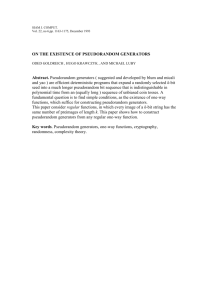
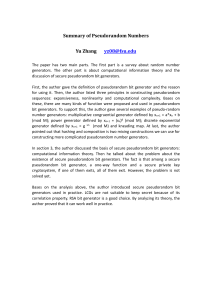
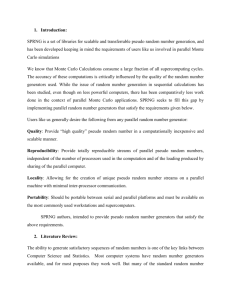


![√ 1. Let q be a prime, R = Z and... q]. Find the primes in S](http://s2.studylib.net/store/data/010491181_1-12c1abdcf573057c81f53ce2532c9451-300x300.png)
